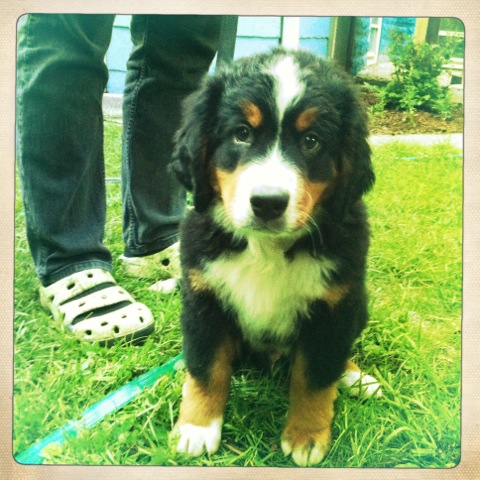May 8, 2014
Many of the serious behavior problems seen in adult dogs are rooted in incomplete or improper socialization. Yet adopters of young puppies often don’t learn what socialization really is, or why it’s so important, until it’s too late.
 Part of the confusion lies in how we use the word casually in the human world. Socialization in canine developmental terms isn’t just hanging out with other dogs. It’s a time-sensitive process that needs to be well under way before your puppy is 12 weeks old. Between three and four months of age, the developmental stage known as the critical socialization period ends, and your puppy is more likely to be apprehensive about or even fearful of things he has never experienced before—whether or not they are a real threat. As he matures, unaddressed fear can manifest as anxiety and aggression. Imagine the challenges a human child who never left the house until it was time to go to kindergarten would face and you’ve got a rough idea of what an unsocialized dog is dealing with.
Part of the confusion lies in how we use the word casually in the human world. Socialization in canine developmental terms isn’t just hanging out with other dogs. It’s a time-sensitive process that needs to be well under way before your puppy is 12 weeks old. Between three and four months of age, the developmental stage known as the critical socialization period ends, and your puppy is more likely to be apprehensive about or even fearful of things he has never experienced before—whether or not they are a real threat. As he matures, unaddressed fear can manifest as anxiety and aggression. Imagine the challenges a human child who never left the house until it was time to go to kindergarten would face and you’ve got a rough idea of what an unsocialized dog is dealing with.
Socialization means exposure to people, places, things, sounds, smells, surfaces, other animals, and experiences that he will need to be comfortable with. Your puppy should be exposed to new people and novel experiences every day. He should encounter the mail carrier and heavily perfumed women and smokers and beardos and men in hats. He should make happy visits to the vet and the groomer, and take other car rides to nowhere in particular. He should hear thunder and fireworks and trucks, watch a vacuum cleaner and a bicycle and a wheelchair in action, meet a dog-tolerant cat, and walk on grass, concrete, gravel, mulch, and manhole covers. If you live in the city, take a field trip to the country, and vice-versa.
Exposure alone isn’t enough: this exposure needs to be positive. Your puppy needs to learn that all these things are safe, or even better, that they predict good things for him. (This is extra important during “fear periods,” times when a bad experience is more likely to have a lasting effect. The first of these usually occurs between eight and 10 weeks; the second some time during adolescence.) Your job is to create a little canine optimist. Bring treats with you on socialization outings and use them to proactively create positive associations with various experiences, without waiting to see if your puppy gets scared. Take things at your puppy’s pace, and don’t force confrontation. It’s not a requirement that your pup be physically handled by every stranger on the street—especially if he seems overwhelmed by such interactions, or if you’d like him not to mug every person he meets for attention in the future. Back up a few feet and instead start by associating treats from you with the person just being nearby.
An excellent resource on how to socialize a puppy is the book Puppy Start Right, by veterinary behaviorist and veterinary technician Ken and Debbie Martin. (The authors also offer a course for instructors, of which I’m a graduate.)
Finally, enrolling your puppy in a well-run group class before the age of 12 weeks provides not just a wealth of socialization opportunities but also a head start on formal training and professional guidance on common puppy issues. Contrary to older recommendations, puppies should not wait until they are fully vaccinated to attend a well-run group class—for more info, check out the current position of the American Veterinary Society of Animal Behavior, the professional organization for veterinarians who specialize in behavior. Operation Socialization’s website provides good advice on protecting your puppy’s health while socializing him.
The process of creating and maintaining positive associations with new experiences shouldn’t stop at 16 weeks. But if your dog is already four months or older and showing fear, the solution may not be the same kind of exposure recommended for puppies who are still in their critical socialization period. Contact a qualified behavior professional to help you get back on track.
A version of this article was originally published in One Tail at a Time’s Ask a Trainer column in November 2013. Kiki Yablon, KPA CTP can be reached directly for private or group training via Dog Training by Kiki Yablon.

Recent Comments